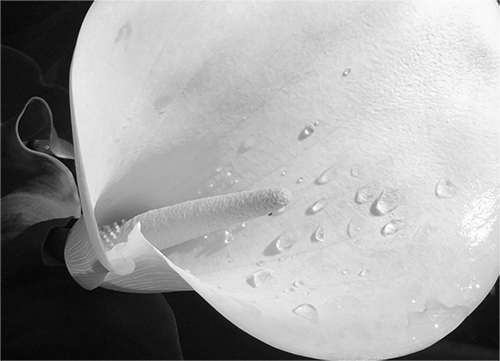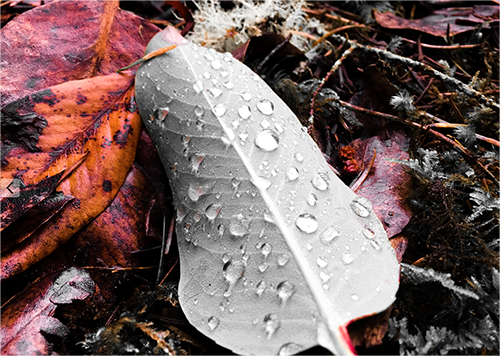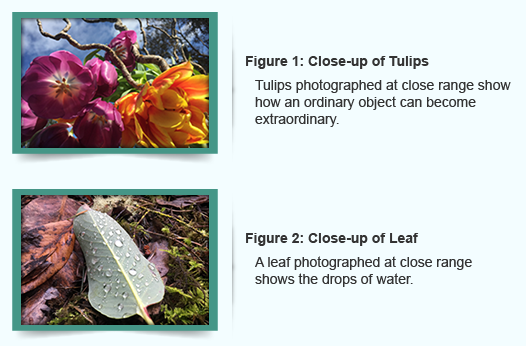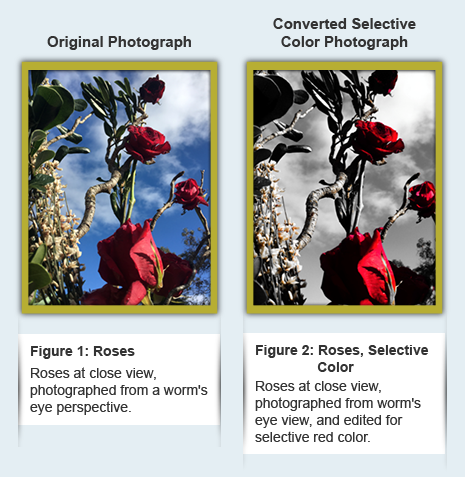Week 6
A New View

Closeup photograph of a lily
shows how simplification can create a
powerful, abstract photograph.
This week, you will explore how to use a camera to create a new view of ordinary objects, and therefore, create a dynamic visual experience. You will build on what you learned in Week 5. This week, you will explore how camera angle, lighting, and proximity to subject matter can make the ordinary seem extraordinary. You will take abstract photographs of four different objects to make them unrecognizable or different from how they appear. Abstract photographs break away from traditional representations of physical objects. Abstraction explores the relationships of forms—such as colors, shapes, and textures—whereas more traditional photography represents the world in recognizable images.
There are limitless options for subject matter. You can use common household objects, flowers from a grocery store, children’s toys, books, crayons or even pens and pencils for this assignment. The key is to use four different objects, or sets of objects, to create four different abstract images. The important thing is to get a new perspective on your subject matter, see how close you can get while staying in focus, or look at something with a new perspective. Be sure to review the lecture material this week on abstraction and selective color.
Weekly Objectives
-
Learn proper digital camera operation.
-
Learn color evaluation and color correction techniques.
-
Explore experimental lighting and digital special effects.
-
Learn proper resample techniques.
-
Learn basic digital image enhancements using image editing programs.
-
Present digital photographs using basic design principles.
Activities
Readings
-
A Short Course in Digital Photography
-
Chapter 7: Organizing and Storing
-
Chapter 8: Lighting
-
Research images taken by the following photographers using the links below or your favorite online search tool:
Activities
-
Discussion 6
-
Shooting Assignment 6
-
Quiz 6
Abstract Photography

Black-and-white leaf surrounded
by red background shows an
abstract composition.
What is abstract photography? Abstraction is the distortion, simplification, or reconceptualization of an object. An abstract photograph does not have to be completely different from what you see in the real world; you can look at an object in a new way by getting up close or using image editing software to make slight changes, such as selective color or blurring. Abstract photographs break away from traditional representations of physical objects, and explore the relationships between forms and colors, light and shadow, and space and depth.
One way to approach abstraction is to simplify the subject. You can get close to the subject to remove background information from the object. Look for patterns in nature that you can shoot closely and frame in your camera. Don’t be afraid to tilt the camera while you shoot. Look for unique shapes on walls or buildings. Explore how light makes objects stand out from backgrounds. You can also shoot through windows or screens. You can use the camera and image editing software to change the way something looks, reorient an object, or distort reality.
Abstraction
Photography is a powerful art form. By being aware of camera angle, lighting, and proximity to subject matter, you have the power to make the ordinary extraordinary. This is the basis of abstract art. Abstraction is a distortion or simplification of reality. By slight changes in camera mechanics, you can begin to truly explore the power of photography to create dramatic and dynamic images.
To begin to explore abstraction you need to learn to see ordinary objects in a new way. Take a new perspective, get below your subject matter, explore getting as close as your lens can focus, or stand above the subject. You can also explore tilting the camera.
Essential to making a successful abstract image is lighting.
Ideal subject matter for this assignment includes food, flowers, or objects that can be easily moved around to outside sunlight, fog, or shadows. Background cloths, such as patterned fabrics, scarves, or sarongs are very helpful. You can use props as well.
A New View: Turning the Ordinary into the Extraordinary

Selective Color
Another way to enhance your image is by exploring selective color. You may explore selective color in this assignment. Selective color is not required, but is an option. There are a few ways to do achieve this technique.
In Camera Conversion
If your camera can do selective color, it is usually accomplished through the edit menu. You choose the color you want to retain, then convert the image. Again, refer to your camera’s manual for directions. If you don’t have the manual, search for it online.

Image Editing
If you own Photoshop, you may do it with the application, but it involves many steps, including layer masks, hue/adjustments and conversion. You are recommended to follow this tutorial.
Controlling Selective Color Changes in Lightroom
Select the play icon, or use the Enter key to watch the video.
An accurate captioning of Controlling Selective Color Changes in Lightroom video is available.
In this video, Julieanne Kost demonstrates how to use Hue, Saturation, Luminance, and the Adjustment Brush to selectively control color in Lightroom.
Note: although this video was recorded in Lightroom, the same techniques are available in Adobe Camera Raw in Photoshop.
If you own Photoshop or have a Creative Cloud membership, you have access to the app Photoshop Express for mobile devices. This has a premium preset for selective color that works fabulously by converting everything to black and white except oranges and reds.
A New View
Select the play icon, or use the Enter key to watch the video.
The images in the video show how the camera can be used to isolate, reframe, and re-contextualize subject matter to present a new view on common objects.
Conclusion
This week helped you to explore abstraction in photography. You created four different abstract images, explored the relationship between form and design, and turned the ordinary into the extraordinary. Next week, you will explore the wonders of low light and night photography.